Rabbit food: Veggie-forward breaks from festive feasting
Sign up now: Weekly recommendations for the best eats in town
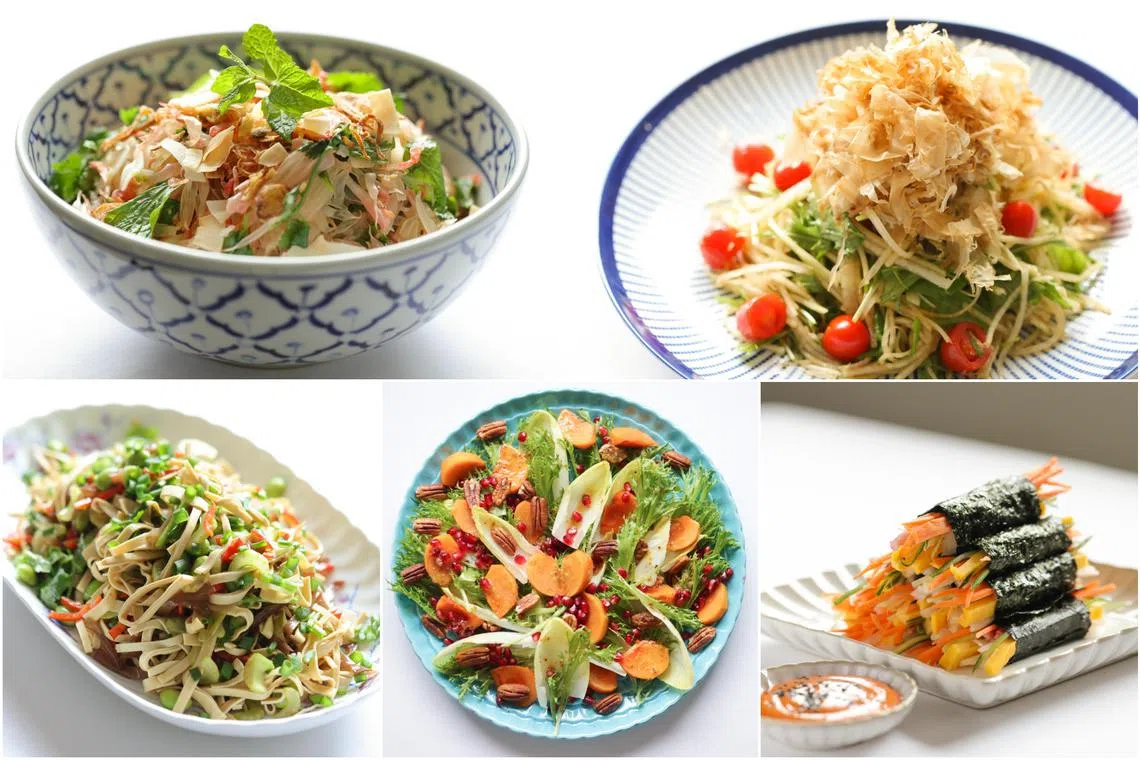
(Clockwise from top left) Pomelo salad, Daikon salad, No Bap Kimbap, Persimmon salad and Baiye salad.
PHOTOS: ONG WEE JIN
Follow topic:
SINGAPORE – Bam, bam, bam – there has been no break between Christmas, New Year and Chinese New Year. And now, we are at the start of 15 days of celebration for the Year of the Rabbit.
Are your taste buds craving less richness and more freshness? Are you filled with trepidation at all the rich meals still to come? Are you all partied out?
My answer to these questions is yes. But I am not a party pooper. I am just pooped.
The strategy I have come up with is to build in healthy-ish meals between the decadent ones. So you will see that there is oil in four of the salad dressings, and there are nuts, fruit and crunchy things – what I think of as naughty with the nice.
Radish, endive, persimmons and pomelo, all of which are in season now, form the base of these veggie-forward recipes. And this being Chinese New Year, the sushi counters at supermarkets carry trays of shredded vegetables, which makes putting salads together very convenient.
In fact, you can make all these recipes without needing special equipment or ingredients. I want to make it as easy to dig into a salad as it is to dig into a jar of pineapple tarts.
Perhaps, on Chap Goh Meh, I will step on the scale and it will not break.
Daikon salad
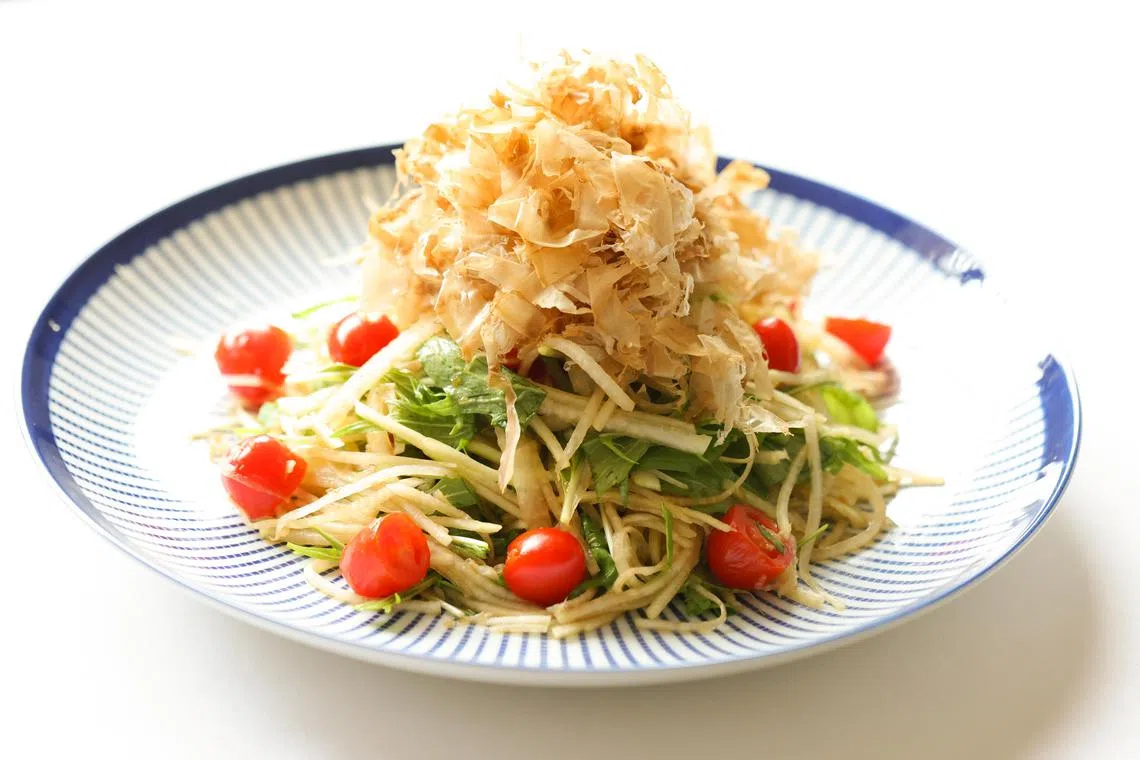
Daikon Salad dressed with wafu dressing.
ST PHOTO: Ong Wee Jin
This simple salad is one I copied shamelessly from a tempura restaurant.
Despite the very underwhelming and underripe tomatoes in the original version, I loved the crunch and sweetness from the radish.
Daikon is in season now and particularly sweet this year. I have made the salad using Japanese, Korean and China daikon and all work well.
Use cherry tomatoes – they tend to be sweeter and have better flavour than larger ones. The wafu dressing is a dependable one from Just One Cookbook, an online treasure trove of home-style Japanese recipes by Namiko Hirasawa Chen.
Ingredients
For the dressing
40g to 50g onion, grated
45ml neutral-flavoured oil such as avocado, canola, rice bran or vegetable
45ml rice vinegar
45ml shoyu
1 Tbs sugar
1 tsp toasted white sesame seeds
For the salad
400g daikon
100g mizuna or pea sprouts
150g to 200g cherry tomatoes
20g bonito flakes
Method
1. Pour all the ingredients for the dressing into a clean glass jar with a tight-fitting screw-on lid. Screw on the lid and shake vigorously to emulsify the ingredients and dissolve the sugar. Have a taste and adjust the seasonings if needed. Refrigerate until ready to use. Shake a few times before using. Leftover dressing keeps in the fridge for up to one week.
2. Peel the daikon and cut into thin strips. Cut the mizuna crosswise into lengths similar to the daikon. Halve the cherry tomatoes.
3. Place all the vegetables in a large mixing bowl and give everything a good toss. Add 2 to 3 Tbs of dressing and mix well. Do not overdress the salad. Pile onto a plate or bowl and top with bonito flakes. Serve immediately.
Serves four
Persimmon salad
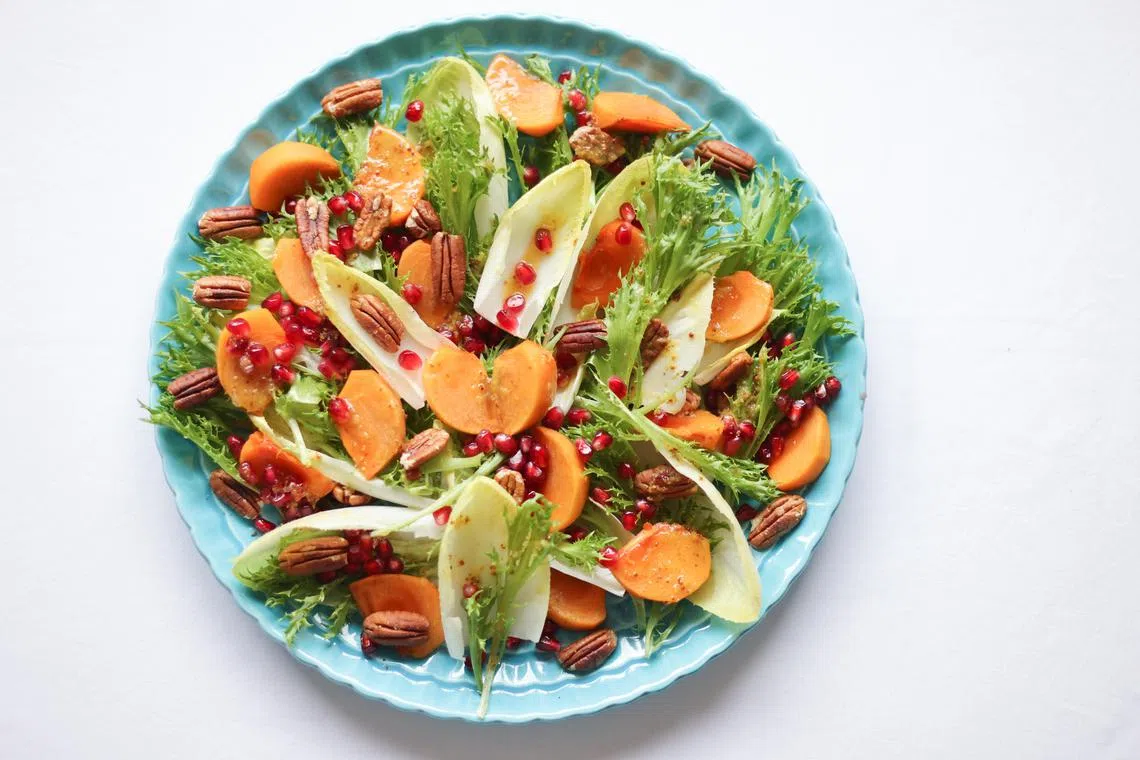
Persimmon Salad offers both sweetness and crunch.
ST PHOTO: ONG WEE JIN
Persimmons are everywhere in supermarkets and fruit shops now, and you want squat, round Fuyu persimmons for the salad, rather than the long, oval Hachiya variety.
Fuyus have a crunchy texture, but they need to ripen at room temperature or they are unpleasantly astringent. I let mine sit out for a couple of weeks, and eat them when they yield slightly to the touch. Sweetness and crunch are my rewards.
I love the slight bitterness of endive, but if you don’t, use baby spinach or something crunchy, like Romaine. Serve this salad with grilled fish or meat. Or make it more substantial by crumbling over some blue cheese and serving the salad with warm bread.
Ingredients
For the dressing
Zest of one lemon
3 Tbs extra virgin olive oil
3 Tbs lemon juice
1 Tbs grain or Dijon mustard
1 Tbs honey
Salt and pepper to taste
For the salad
75g to 100g raw pecans
2 Fuyu persimmons
200g endive
150g frisee
2 Tbs pomegranate arils (optional)
Method
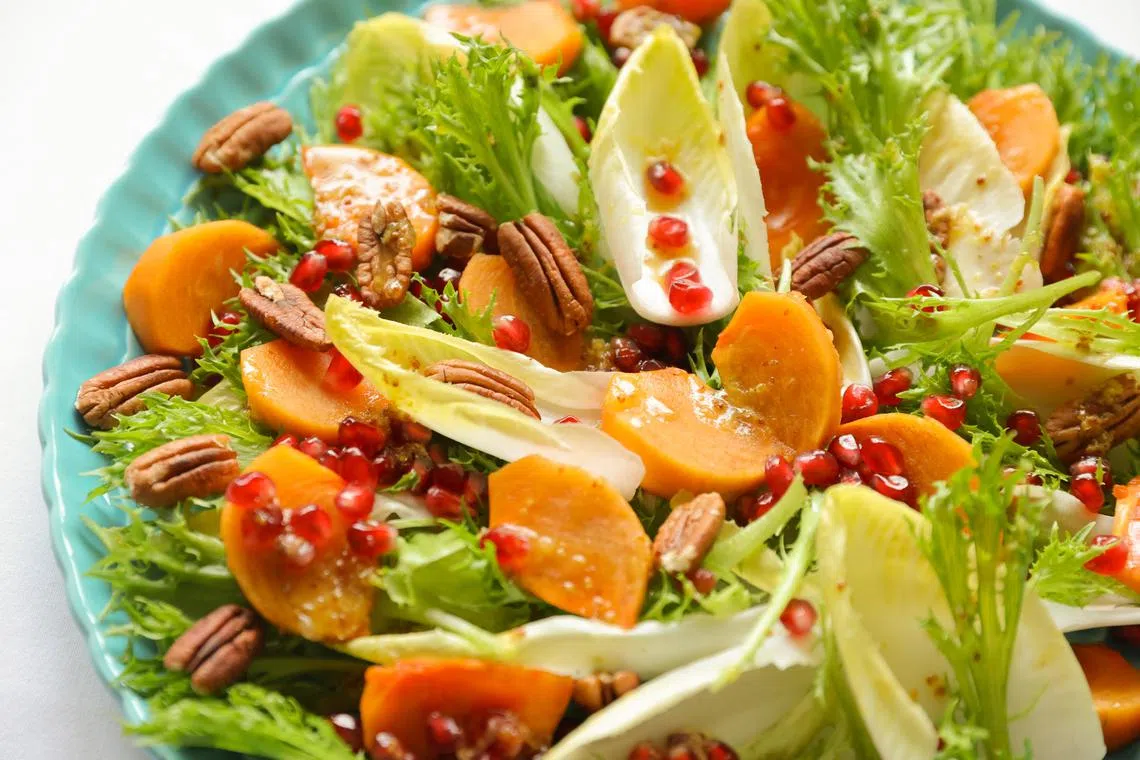
Persimmon Salad offers both sweetness and crunch.
ST PHOTO: ONG WEE JIN
1. Place all the ingredients for the salad dressing in a clean glass jar with a tight-fitting screw-on lid. Screw on the lid and shake vigorously to emulsify the ingredients. Add ½ tsp salt and a few grinds of black pepper. Shake the jar again. Have a taste and adjust the seasonings if needed. Refrigerate until ready to use. Shake the jar before using. Leftover dressing will keep in the fridge for up to a week.
2. Toast the pecans in a non-stick pan over medium-low heat for six to eight minutes or until fragrant. Do not leave them unattended because they burn easily. Place on a plate to cool while you prepare the other ingredients.
3. Wash the persimmons and dry with paper towels. Peel the fruit using a vegetable peeler and cut each one into eight wedges. Separate the leaves from the head of the endive and cut or tear them into bite-size pieces. Separate the frisee into smaller clumps.
4. Arrange the endive, frisee and persimmons on a large serving plate. Scatter over the pecans and pomegranate arils (if using). Spoon the dressing over or serve it on the side for guests to help themselves.
Serves four
Pomelo salad

Pomelo Salad topped with shallots, coconut flakes and sakura ebi.
ST PHOTO: ONG WEE JIN
I love the sweet-tart pink variety of pomelo for eating out of one’s hand or in a Thai-style salad. The fruit is the star here, but mint and coriander play vital supporting roles. Coconut flakes – the kind sold in supermarket as snacks – and store-bought fried shallots add crunch.
A pomelo salad in Thailand would have soaked and pounded dried shrimp. I want instant gratification and this comes in the form of sakura ebi, which you can buy in supermarkets. Make this more substantial by adding cooked prawns or shredded chicken and omitting the sakura ebi.
Ingredients
For the dressing
4 Tbs lime juice from large limes, not calamansi
Zest of the limes you used to get the juice
2 Tbs fish sauce
1 Tbs sugar
For the salad
1 small pomelo, 1kg to 1.2kg unpeeled
4 to 5 sprigs of mint
4 to 5 sprigs of coriander
2 large red chillies
2 Tbs store-bought fried shallots
3-4 Tbs toasted coconut flakes
10g to 15g sakura ebi
Method
1. Place all the ingredients for the dressing in a clean glass jar with a tight-fitting screw-on lid. Screw on the lid and shake vigorously until the sugar dissolves. Have a taste and adjust the seasonings, if needed. Refrigerate until ready to use. Leftover dressing will keep in the fridge for two to three days – the lime juice will lose its punch the longer it keeps.
2. Remove the peel of the pomelo, as well as the pomelo sacs from the pith. Break up into smaller chunks and place in a large mixing bowl. Remove the leaves from the sprigs of mint and coriander and add them to the bowl. Slice the chillies in half lengthwise, remove the seeds and cut into thin strips.
3. Add most of the shallots, coconut flakes and sakura ebi to the bowl, reserving some of all three for garnishing. Spoon over 2 to 3 Tbs of the dressing and mix thoroughly. Spoon into a serving bowl, top with the reserved shallots, coconut flakes and sakura ebi and serve immediately.
Serves six
Baiye salad
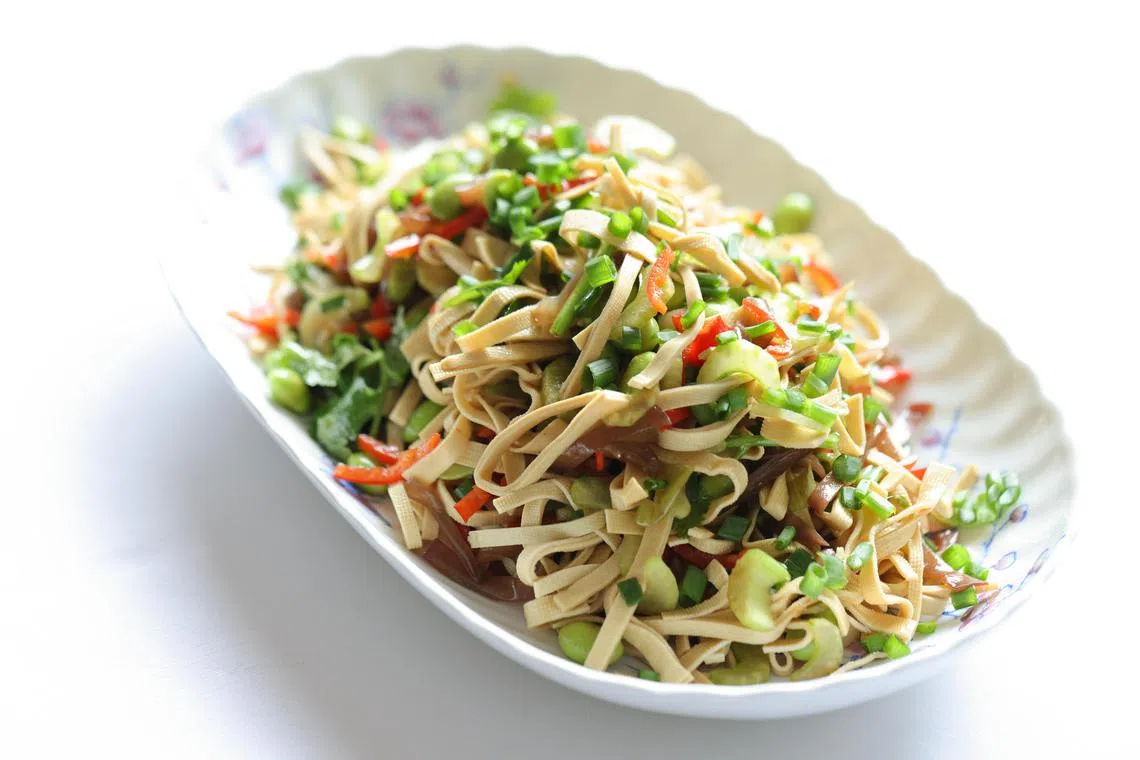
Baiye tofu, which are thin sheets of pressed tofu, is used in place of noodles in this carb-lite Baiye Tofu Salad.
PHOTO: ONG WEE JIN
This “salad” is really a noodle dish in disguise. When I feel the need to go carb-lite, I buy a packet of baiye tofu – which are thin sheets of pressed tofu – cut them into long strips and use them in place of noodles.
This dish is inspired by the little appetisers in a Shanghainese restaurant I go to. I love the mellow vibe of black vinegar in the dressing because it perks up a jaded palate. Of course, you can swop out the vegetables. But I love celery for the crunch and edamame for the protein.
Buy trays of rehydrated black fungus for the salad. Many supermarkets carry them. You can also mix in a couple of tablespoons of roasted peanuts for crunch.
Ingredients
For the dressing
2 Tbs sesame oil
1 Tbs chilli oil
3 Tbs black vinegar
2 Tbs soya sauce
2 tsp sugar
For the salad
250g baiye tofu
150g edamame beans
2 to 3 ribs of celery
150g rehydrated black fungus
2 to 3 large red chillies
4 to 5 sprigs of coriander
Method
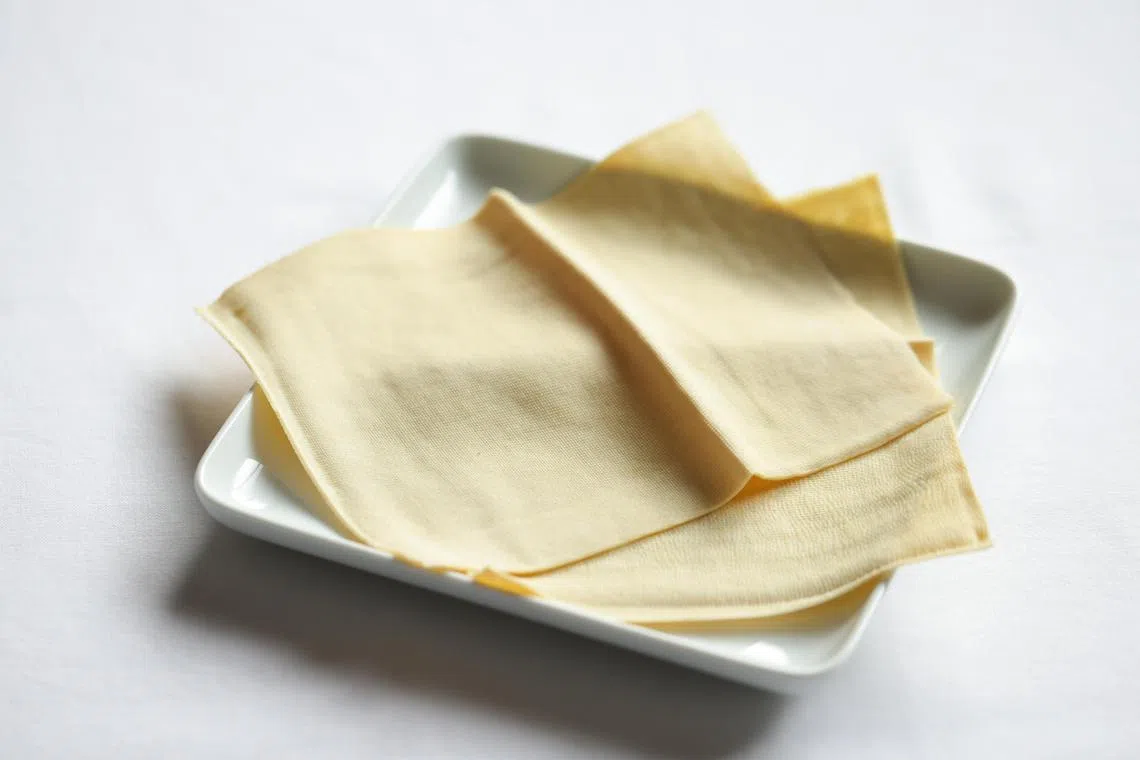
Thin sheets of Baiye tofu.
ST PHOTO: ONG WEE JIN
1. Place all the ingredients for the dressing in a clean glass jar with a tight-fitting screw-on lid. Screw on the lid and shake vigorously until emulsified and the sugar has dissolved. Have a taste and adjust the seasonings if needed. Refrigerate until ready to use. Leftover dressing keeps in the fridge for up to a week.
2. Bring a large pot of water to a boil. Unwrap the baiye tofu, cut into smaller pieces, stack them up and slice as thinly or widely as you like. Plunge the baiye into boiling water and cook for two minutes. After one minute of cooking, add the edamame beans to the pot to reheat for the remaining minute. Pour both into a colander and let drain while you prepare the rest of the ingredients.
3. Using a vegetable peeler, peel the rounded side of the celery – this removes the stringy, fibrous parts of the vegetable. Trim off both ends and cut crosswise into thin half moons. Rinse the black fungus under running water and dry with paper towels. Slice off and discard the root ends of the fungus. Cut the fungus into thin strips. Slice the chillies in half lengthwise, remove the seeds and cut into thin strips. Roughly chop the coriander but reserve some leaves for garnish.
4. Place all the salad ingredients in a large mixing bowl. Shake the glass jar with the dressing and pour all of it onto the salad. Mix well. Transfer to a serving platter and serve immediately.
Serves six to eight
No Bap Kimbap
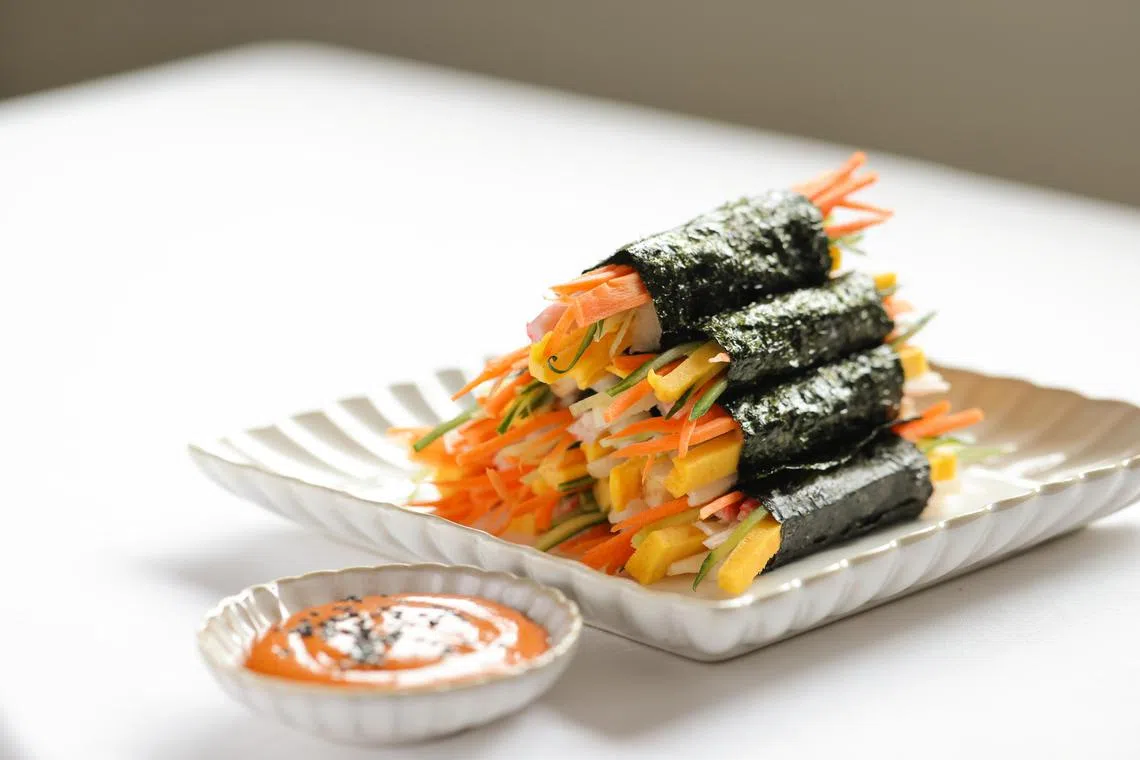
No Bap Kimbap with tamagoyaki, cucumber, carrot, Korean pear and crab sticks.
ST PHOTO: ONG WEE JIN
Futomaki or kimbap, depending on whether you are in Japan or Korea, are rolls of rice and vegetables, with protein or not, bundled up in sheets of nori. The rice can sometimes weigh me down, and I make my own without it.
The idea is simple: Set out plates of julienned vegetables, protein and nori sheets, and have your guests roll their own. The less time there is between hand and mouth, the more crisp the nori will stay. I use nori sized for onigiri. They are narrower than the sheets used for maki and make convenient single-serve rolls.
The only recipe here is for the dipping sauce, which is adaptable to whatever you have on hand. Don’t have Japanese mayonnaise? Use the regular kind. Any chilli sauce lurking in the fridge can go into the dip. No rice vinegar? Use lemon juice or whatever vinegar you have on hand.
I made these rolls using strips of tamagoyaki cut from a block. Many supermarkets carry them.
Julienned cucumber, carrot and Korean pear add crunch and sweetness, and crab sticks add protein. Other suggestions: mizuna cut into 8cm to 20cm lengths, Japanese or Korean perilla leaves, takuan or Japanese radish pickles, and store-bought shredded carrot, radish and cucumber meant for do-it-yourself yusheng.
Protein options include sashimi-grade raw fish, strips of unagi, canned tuna, cooked prawns and leftover strips of steak. You are limited only by your imagination.
Ingredients
For dipping sauce
100g Kewpie mayonnaise
30g gochujang (Korean fermented chilli paste)
2 tsp rice vinegar
2 tsp sesame oil
2 tsp toasted sesame seeds
Method
Mix all the ingredients except the sesame seeds thoroughly and refrigerate until ready to use. Keeps up to three days in the fridge. Sprinkle with toasted sesame seeds before serving.


